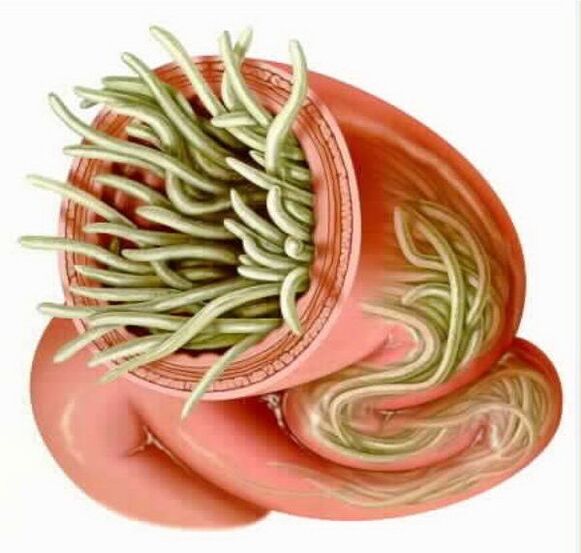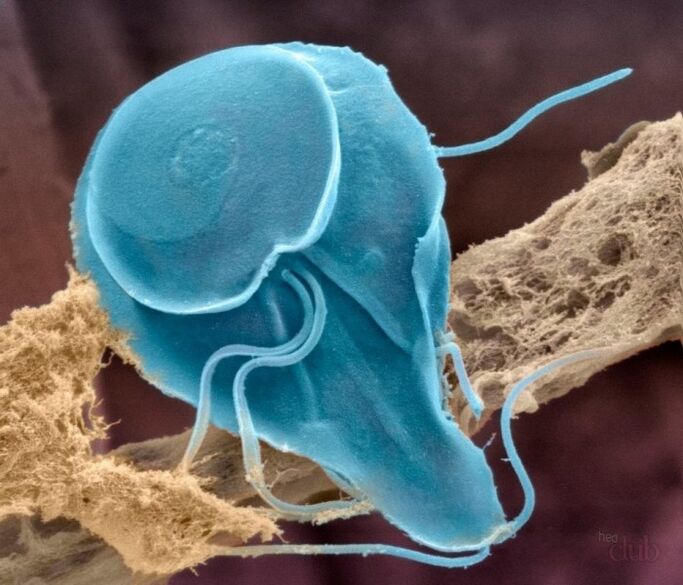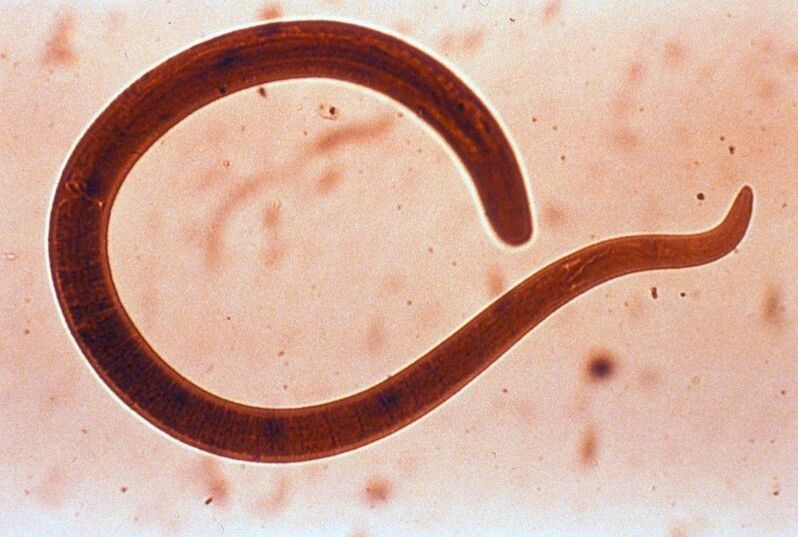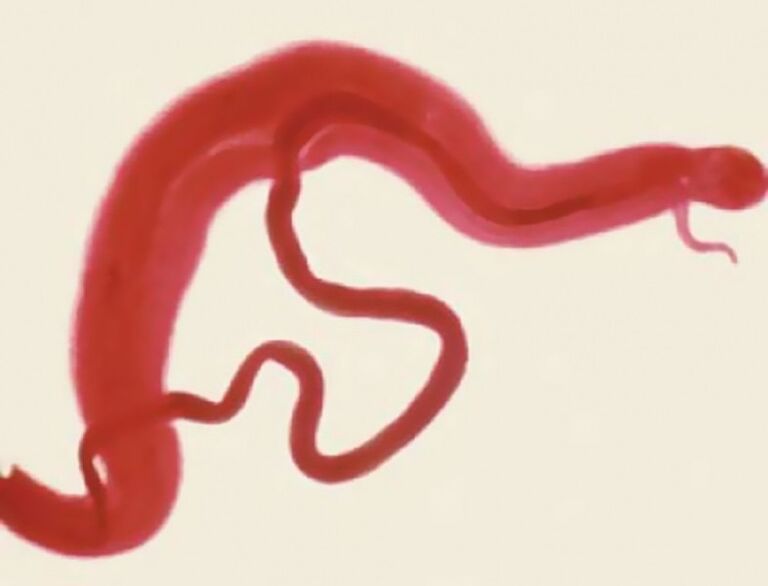Parasites in the human bodyappear completely unexpected. The reason is usually a direct contact with the source of the infection, for example with an infected person or object. There are many types of parasites that can settle in the human body: such as lamblia, pinworms, alveococci, trichinella, schistosomes, etc.
Parasites in the human body

The human body has a relatively complex structure, which is susceptible to various diseases and infections, infections, viruses, and parasites. Parasites that live in the human body are microorganisms that live a parasitic lifestyle, trying to survive by eating other organisms, microorganisms, cells, etc.
Parasites that live in the human body are microorganisms that live a parasitic lifestyle, trying to survive by eating other organisms, microorganisms, cells, etc.
Parasites that find fertile soil for life and reproduction in the human body, causing very serious, sometimes irreparable harm to their health, destroying the body from within, eating it and sometimes leading to the death of a person, or stopping the work of organsthe individual, who also worsens a person’s quality of life, suffers from depression and, ultimately, shortens his or her life.
There are millions of species of parasitic worms in nature. Of these, only one parasite is a representative of the animal world. But in nature there are also species that can exist in the body of some species of animals. What parasites live in the human body is a question that many people ask.
Various species of helminths can live in the human body. Some of them are very rare, while others live very often inside and can lead to parasitic lifestyles for decades.
Variety of parasitism
There are the following types of parasitism: ectoparasites - parasites that live a superficial lifestyle in the human body. This category includes lice, bugs, lice; endoparasitism - a parasite that affects a person's internal organs. They are further divided into two large groups of protozoa and helminths.
Types of parasitic protozoa: lamblia, toxoplasma, trichoionada. This type of protozoa parasite is most often found in the human body.
The classification of parasites associated with helminths shows its division into three major groups: nematodes; trematod; cestode.
Types of parasites in the human body
Pinworms
Pinworms are the most well-known parasites in the gut. The disease caused by cream worms is called enterobiasis. Not just people who suffer, but also big monkeys. High-risk children get a cream worm infection. According to various sources, their level of involvement in enterobiasis at preschool age ranges from 25 to 90%. Pinworms are passed on from one person to another. Infection occurs through the handshake, clothing and objects touched by the sick person, provided that after contact the hands are not washed and the worm eggs enter the mouth (this occurs mainly during eating).
Flies and cockroaches can carry the eggs of these nematode worms by sowing their food. Cream worms live in the small intestine, in the cecum, in the large intestine. They mate in the ileum, after which the female crawls out of the anus through the rectum and lays her eggs in the anus.
Symptoms of enterobiasis are itching in the anal area, intoxication (allergic reactions, fatigue, fatigue), anemia, increased eosinophil levels in the blood, insomnia, and abdominal pain.
To get rid of enterobiasis, anthelmintic drugs are used. The dose and method of treatment are chosen by the doctor. To prevent re-infection, it is important to keep your hands clean, wash them after visiting public places, after using the toilet, before eating, etc.
Nails should be cut short, beds and underwear should be disinfected, and the apartment should be cleaned daily.
Toksokara
Toxocara is a parasite from the nematode group. The disease caused by toxocara is called "toxocariasis". These invasions in humans can take the form of larvae (ocular and visceral), as well as intestines. The disease is spreading all over the world. Toxocara infection occurs when worm eggs enter the human digestive tract. This is most often seen when eating food or water contaminated with dog feces. Contact with sick animals is no less dangerous.
The natural carriers of Toxocara are cats and dogs, foxes and wolves. Once inside the human body, worm larvae move through the bloodstream and can settle on any organ. The symptoms of the disease will depend on this. Often, toxocariasis manifests itself in the form of allergic reactions (Quincke edema, skin rash, bronchial asthma). During exacerbation of the disease, body temperature can rise to 38 degrees, but symptoms of body poisoning are poorly expressed.
Toxocariasis can be suspected by enlarged lymph nodes: forms of visceral toxocariasis are the most common, occurring with damage to internal organs (intestines, respiratory system, heart valves).
A person may experience abdominal pain, right hypochondrium, dyspeptic disorders, nausea; if the respiratory system is damaged, a person suffers from shortness of breath, tuberculosis, shortness of breath; if the toxin settles in the heart valve, then the patient has weakness, blue fingers and nasolabial triangle, shortness of breath; skin form characterized by itching, feeling of movement under the skin, inflammation of the skin and mucous membranes; in neurological form, the parasite provokes the development of inflammation of the meninges and the brain tissue itself.
It manifests itself in headaches, nausea and vomiting, seizures and other neurological disorders. For the treatment of toxocariasis, anthelmintic drugs are used, as well as pathogenetic and symptomatic therapy.
Ascaris Manusia
Ascaris Humans are ringworms that falsify the small intestine. The disease caused by this parasite is called ascariasis. The owner of the ringworm and the source of the infection is the sick person. Along with its feces, worm eggs enter the soil, where they mature to larvae. Then the soil is transferred to food or into human hands, and if personal hygiene rules are not followed and if fruits, vegetables and berries are poorly processed, they are transferred to the digestive tract.
Children and the rural population are more susceptible to infection. Ascariasis manifests itself in various stages of its development in different ways. During the larval migration phase through the body, an increase in body temperature, tuberculosis appears, wheezing in the lungs, and the lymph nodes increase. Children suffer from ascariasis more severely than adults.
Allergic skin reactions are typical symptoms of ascariasis. During parasites in the intestine, patients experience dyspeptic disorders, loose stools are replaced by constipation, frequent abdominal pain, nausea and vomiting occur. On the part of the nervous system, hysterical seizures, insomnia, mental fatigue, and headaches are observed.
For the treatment of ascariasis at the stage of larval migration, patients are prescribed some anthelmintic drugs, while worm parasites in the intestine, others.
Hookworm and nekator
Mining worms and nekators are two types of ringworms that belong to the family Ancylostomatidae and cause a disease called minerworm. There are two ways to infect the human body with this parasite - fecal-oral (drinking contaminated water, fruits, vegetables) and percutaneous contact with soil (penetration occurs through the skin).
Clinical symptoms of ankylostomiasis: papular vesicular rash, shortness of breath and cough, loss of appetite, nausea, abdominal pain, loose stools, iron deficiency anemia. Treatment is reduced to taking anthelmintic medication and eliminating anemia with iron preparations.
Wide band
Wide tapeworm refers to tapeworm from the Pseudophyilidea sequence. These parasites live in the small intestines of humans and mammals that eat fish. Infection with tapeworm provokes the development of diseases such as diphyllobothriasis.
There are 12 types of tapeworms that can be parasitic in the human body, but the widest tapeworms are the most common. Infection occurs when eating fish or caviar is light and not thermally processed, which contains worm eggs. Symptoms of the presence of parasites in the intestine: nausea, abdominal pain, anemia.
In severe cases, intestinal obstruction develops. To get rid of parasites, patients are given antiparasitic drugs. Upon completion of the course of therapy, a second study is mandatory for the presence of worms in the body. If necessary, the use of anthelmintic medication is repeated.
Bull tapeworm
Bull tapeworms are tapeworms belonging to the teniid family. At the larval stage, it affects the cow, and at the stage the tapeworm lives in the human body (in the gut). Tapeworm provokes a disease called teniarinhoz, as a rule, a parasite is found in the patient's body. Human infection occurs through the digestive tract after eating meat (beef) that does not get heat.
Clinically, the disease is manifested by nausea, excessive appetite, pain in the abdomen, unstable stools, and allergic reactions of urticaria. To remove the bovine tapeworm from the body, an anthelmintic agent is prescribed. In parallel, the patient should adhere to a slag-free diet, put on a cleansing enema, take laxatives. After using an anthelmintic agent, the worm dies and leaves the human body naturally. Sometimes its length can reach 12m.
Pig tapeworm
Swine tapeworms are parasitic tapeworms that infect mammals. Intermediate carriers can be pigs, dogs, rabbits, camels, but the main owners are always men.
If adult parasites are found in a person's body, then they are talking about diseases such as teniasis. When the parasite is in the patient's body at the larval stage, the disease is called "cysticercosis".
Pig tapeworm infection occurs when unprocessed pork is eaten. Sometimes the source of cysticercini is hand or water sowing. A patient with teniasis poses an epidemiological danger to himself (infection by brain, skin, eye or skeletal muscle larvae) as well as others.
Symptoms of teniasis: abdominal pain, loss of appetite, severe stools, headaches, frequent dizziness, fainting (brain and eye teniasis are very dangerous). For the treatment of teniasis, the patient is hospitalized. Under the supervision of a doctor, he was prescribed anthelmintic medication, after which, after 2 hours, the patient took a salt laxative, which allowed him to get rid of the worm segments and eggs. For the treatment of cysticercosis of the eyes and brain, surgical intervention is required.
Echinococcus
Echinococcus is a tapeworm of the order Cyclophyllidae. Adults carry parasites in the intestines of dogs and cats, and are found in wolves and wolves. For humans, parasitic larvae are dangerous, which can cause serious diseases - echinococcosis. Larvae can infect a person’s internal organs, forming echinococcal cysts in them. For echinococci, humans act as intermediate hosts.
Infection is done by contact (in the process of cutting carcasses, when interacting with sick animals), or food (while eating contaminated food or water). At risk are people who are involved in livestock or who are in constant contact with animals. Symptoms may not appear for many years.
When asymptomatic stages end, pain, itching of the skin, and urticaria appear at the site of larval invasion. In addition, organ function in which parasitic echinococcus larvae suffer. Increased body temperature and fever are observed during cyst suppuration.
Complete cure of echinococcosis is only possible with surgery. The cyst peels off, being careful not to damage the membrane. If the bladder is very large, then the puncture and its contents are sucked. Before and after surgery, patients are given antiparasitic drugs. If the radical removes the cyst, the prognosis for recovery is good.
Alveococcus
Alveococcus is a helminth of the cestode group. The worm screams a life-threatening alveococcosis, characterized by the formation of primary foci in the liver with subsequent spread of metastases to other organs. Infection occurs when parasitic oncospheres enter the mouth.
This can happen while hunting, in the process of cutting the carcasses of wild animals, in contact with domestic animals, or when eating unprocessed berries and herbs from the forest. Symptoms of alveococcosis are reduced to pain in the right hypochondrium, belching, nausea. Often there is itching, allergic reactions. Shrinkage of tumors with parasites and their penetration into the abdominal cavity or pleura is not excluded.
Alveococcus metastasis can be found in the brain and lungs. Treatment of this disease is immediate, but should be supplemented with the intake of antiparasitic drugs.

Giardia
Giardia (another name for Giardia) is a flagellate parasite belonging to the Diplomonadid sequence. Giardia provokes a disease called "giardiasis" and parasites in the human small intestine, as well as other mammals and birds.
Giardia infection occurs through oral-fecal methods: food, water and household contact methods. The most important in terms of infection transmission is the use of raw water, contaminated food, the use of public goods sown with lamblia cysts. The main symptoms of giardiasis are nausea, painful sensation in the stomach, stool disorders, and excessive gas.
In addition, patients experience allergic reactions, intoxication and neurotic disorders. Giardiasis therapy is performed with the help of antiprotozoal drugs, as well as with the inclusion of enzymes, choleretic agents and enterosorbents in the treatment regimen.
Amoeba histologi
Amoeba histology is a protozoa parasite that causes a disease called amoebiasis. The disease is manifested by the formation of ulcers in the large intestine, followed by damage to other internal organs. Infection with amuba occurs through the fecal-oral route, after a mature cyst from water or food enters the human gastrointestinal tract. Possible spread of parasites through unwashed hands. Flies can be carriers of amuba.
Another way to spread amebiasis is through sexual intercourse (anal intercourse). Symptoms of amebiasis: abundant mucus, abdominal pain, blood in the stool, weight loss, anemia. In addition, extraintestinal amebiasis is characterized by the formation of abscesses in the parasite-affected organs (lungs, brain, liver, etc. ).
Antiprotozoal drugs are prescribed to treat intestinal ambiasis.
The duration of therapy is determined by the severity of the amoebiasis.
A disease called gnatostomosis is caused by larvae and sexually mature nematodes of Gnathostoma spinigerum. Infections occur when eating fish, frogs or unprocessed bird meat, as well as drinking undigested and unpolluted water. Symptoms of the disease are expressed in coughing and soreness at the site of penetration of larvae under the skin, at local inflammation and increased body temperature.
Severe edema and itching are common. As a rule, after a week from the onset of symptoms, they disappear, but they recur for many years. Dangerous damage to the eyeballs and brain, often fatal. Treatment involves taking anthelmintic medication and surgery. During surgery, parasites are removed from under the skin.
Trichinella

Trichinella is a round parasitic worm that at the larval stage lives in the muscle (oculomotor, masticatory, diaphragm muscle), and in adulthood - in the lumen of the small intestine. The disease provoked by trichinella is called "trichinosis". It turns off.
Human infections occur through the consumption of raw or unprocessed meat from wild and domestic animals. Symptoms include loss of appetite, vomiting, diarrhea, and abdominal pain. In the future, muscle aches, swelling of the eyelids, and skin rashes combine. Treatment of parasitic attacks is carried out with the help of anthelmintic drugs. At the same time, antihistamines are prescribed, and corticosteroids if needed.
Schistosomes
Schistosom is a coincidence worm in the genus trematoda. They provoke a disease called schistosomiasis. Human infections occur during bathing, in the process of washing clothes or watering the soil with water with schistosomal larvae. They can penetrate into the human body even through intact skin and mucous membranes. Symptoms in the acute stage of the disease are manifested in rising temperatures to high levels, on itchy skin and the appearance of papules throughout the body.
They can penetrate into the human body even through intact skin and mucous membranes. Symptoms in the acute stage of the disease are manifested in rising temperatures to high levels, on itchy skin and the appearance of papules throughout the body.
After the disease becomes chronic, the infected person may show signs of colpitis, prostatitis, colitis, ascites, hydronephrosis, etc. Antelmintic drugs are used to treat this disease. Surgical intervention is required for complications of genitourinary schistosomiasis.
There are many parasites that can harm the human body. A large number of them enter the body of their owner through the gastrointestinal tract if safe food preparation technology is not followed and basic hygiene procedures are not followed.
Parasites in the body - adaptive properties
- long lifespan (helminths live in the human body for many years, and sometimes as long as the parasite host lives);
- the ability to suppress or alter the immune response of the host organism (immunodeficiency conditions arise, conditions created for the penetration of pathogenic agents from the outside, as well as for the "removal" of the internal focus of infection);
- many types of helminths, enter the digestive tract, release antienzymes, which save them from death; digestive processes are disrupted, toxic allergic reactions of various severity appear: urticaria, bronchial asthma, atopic dermatitis;
- developmental stages (eggs, larvae, owner changes);
- eggs' ability to survive for many years in the external environment;
- sexual reproduction, in which the exchange of genetic information takes place, and this is already the highest stage of development, leading to an increase in the heterogeneous population, i. e. the parasites become less susceptible;
- lack of immunization methods, due to weak and unstable immune response;
- helminths are widespread, many habitats (water, soil, air, plants and animals).
Prevention of parasites in the body
Precautions to prevent parasitic attacks should be comprehensive. First of all, it is necessary to adhere to the basic rules of personal hygiene, eat only fruits, washed vegetables, as well as fish and meat treated with heat, drink only clean water.
A large number of experts advocate the prevention of helminthiasis by using pharmaceutical antiparasitic drugs - parasitologists will help you choose the medication needed and calculate the dose correctly.
You can complement this therapy with folk remedies that have an antelmintic effect - for example, eat more onions, garlic, various spices, eat pumpkin seeds regularly.
























